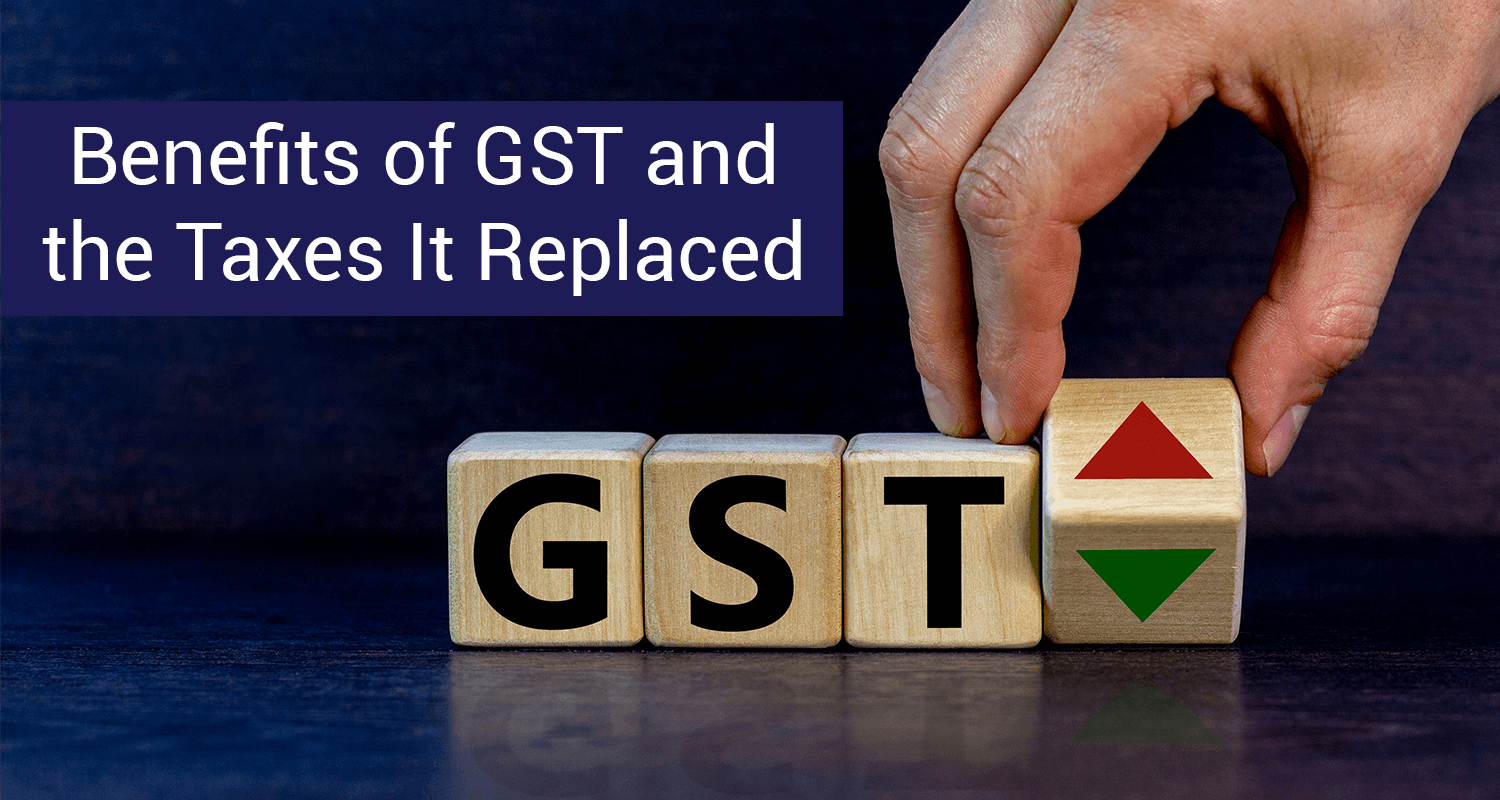Benefits of GST & The Taxes It Replaced

The year 2017 saw a paradigm shift in the Indian tax system, as the Government of India (GOI) introduced the Goods and Services Tax (GST) on 1 July. Before this, India's tax system included several levies – central excise, state VAT, service tax, and additional duties. As these made things complicated for businesses and consumers, GST promised a unified, transparent, and efficient tax regime.
This article looks at GST's impact, exploring its benefits for businesses, consumers, and the Indian economy.
Taxes GST Replaced:
As a comprehensive tax, GST replaced many indirect taxes and duties. These include:
- Central Excise Duty: Levied on the manufacture or production of goods.
- Service Tax: Charged on various services provided.
- VAT (Value Added Tax): Imposed on the sale of most goods within a state.
- Central Sales Tax (CST): Applicable on interstate sale of goods.
Additional duties of excise and customs:
A layer of more levies adds complexity. This complex system caused surging taxation, where taxes were further taxed, thus inflating prices and hindering economic activity. Moreover, compliance became a cumbersome and expensive affair for businesses.GST as a Unified Solution
As GST was introduced, a unified tax system replaced most Central and State indirect taxes, streamlining the process and bringing transparency to the system.The key features of GST include:
Single Rate Structure: Instead of dealing with several tax rates, businesses now operate under a simplified framework with five main rates – 0%, 5%, 12%, 18%, and 28% (with exceptions for certain goods and services).
Input Tax Credit: Businesses can claim credit for the GST paid on their inputs, reducing the final burden on consumers and promoting efficient cost management.
Simplified Compliance: Online processes and standardized forms make it easy to file GST returns.
Transparency and Efficiency: The streamlined system fosters greater transparency and reduces tax evasion, encouraging economic growth. GST has proven beneficial to businesses and consumers alike, besides boosting the economy.
Benefits of GST
GST benefits businesses and industries across the country and significantly facilitates the government and consumers. Below are a few of the major benefits of Goods and Service Tax (GST).
- It makes compliance easy and transparent.
- It enables uniformity of tax rates and structures across the country.
- It offers a seamless system of tax credits across the value chain and state boundaries, which ensures minimal tax cascading.
- It facilitates a reduction in transaction costs, leading to improved competitiveness for the trade and industry.
- It has created a unified set of rules for e-commerce across India, making it easier for businesses to operate nationwide.
- It reduces the cost of locally manufactured goods and services which in turn significantly helps Indian manufacturers and exporters in the international market.
- It simplifies the tax system by replacing multiple indirect taxes with a single tax.
- It includes provisions for online compliance and payments and for availing of input credit only when the supplier has accepted the amount. This has brought accountability and regulation to unorganised and unregulated sectors such as construction and textile.
- It decreases the government's cost of collecting tax revenues, thereby leading to higher revenue efficiency.
- It reduces the overall tax burden on many products, benefiting consumers.
Types of GST
Depending on whether the transaction is inter-state (between two states) or intra-state (within the same state), GST is classified into three types:
- State Goods and Services Tax (SGST)
- Central Goods and Services Tax (CGST)
- Integrated Goods and Services Tax (IGST)
Sapna aapka. Business Loan Humara.
Apply NowBenefits for Businesses:
For businesses of all sizes, GST has brought several benefits:
Reduced Cost of Operations
Elimination of rising taxation and streamlined compliance processes have considerably minimized operational costs.Easier Market Access
A unified national market with seamless interstate movement of goods promotes wider reach and expands business opportunities.Enhanced Competitiveness
Increased transparency and lower costs improve competitiveness in the domestic and global markets.Simplified Tax Payments
Online payment systems and centralized filing procedures make tax payments more accessible and faster.Business Loans
Financial institutions often base the business loan limit on the GST returns filed by the business entity.Benefits for Consumers:
Consumers also benefit from GST in many ways:Lower Prices
Due to reduced input costs and the removal of high taxes, businesses can charge the consumer a lower price for services or goods.Simplified Tax Structure
Tax structure often dissuades individuals from understanding the levy they pay on products or services. However, with GST, they can easily understand the tax breakdown, thanks to the standardized rate structure.Wider Range of Goods and Services
As logistics improve and the national market grows, goods and services become available at competitive prices.Transparency and Accountability
As the system is streamlined and online records are maintained, the result is enhanced transparency and accountability within the tax system.Benefits to the Central and State Governments
GST is also immensely advantageous to India as an economy, besides benefiting the Union and State Governments in the following ways:Simplified Administration
Managing various indirect taxes at both central and state levels often leads to complications and confusion, making administration challenging. The GST's strong and straightforward IT system, guided by the GST Council, promises easier indirect tax management.Improved Tax Compliance
GST's design includes a feature that encourages traders to comply with taxes by transferring input tax credit throughout the value chain. Coupled with a reliable IT setup, this is expected to enhance tax compliance.Increased Revenue
Previous multiple-stage applications of indirect taxes also involved high tax collection costs. However, by reducing these costs for the Government, GST boosts revenue efficiency, as other factors also contribute to increased revenue.Boost in Investments in India
A stable and transparent tax system promotes a robust business environment, which, in turn, attracts both local and foreign investments. Thus, GST is meant to generate employment opportunities, encourage education, foster domestic manufacturing, boost revenue, and more.Benefits for the Economy
GST has also positively affected the Indian economy as a whole.GDP Growth
By lowering tax rates, implementing GST has eliminated multiple-point taxation and enhanced revenues. A uniform tax system can transform India into a unified market, boosting trade, commerce, and exports. These changes will drive economic growth and increase the country's GDP. Experts project this growth to range from 1-2%, with an expected reduction in inflation by around 2% due to GST.Reduced Corruption and Tax Evasion
Corruption has been a significant challenge in India. The robust IT infrastructure, simplified return and payment systems, and reduced human intervention of GST have the potential to significantly curb tax evasion and corruption, offering a crucial step towards a more transparent system.
However, there's also a flip side to the coin. GST has affected some aspects of businesses adversely. For instance, buying GST software or opting for compliance solutions costs money. The tax has increased operational costs as smaller businesses have had to employ or train people who can file returns or pay taxes as per the new laws. Furthermore, the tax burden for SMEs has increased, and smaller businesses have also struggled with the new, completely online way of taxation.
Conclusion
Overall, the unified Goods and Services Tax has brought several benefits to the Indian economy, the Central and State Governments, businesses, and individuals. The cascading of taxes has been eliminated, the compliance burden has been reduced, revenues have increased, and the taxation process has been simplified.
Sapna aapka. Business Loan Humara.
Apply NowDisclaimer : The information in this blog is for general purposes only and may change without notice. It does not constitute legal, tax, or financial advice. Readers should seek professional guidance and make decisions at their own discretion. IIFL Finance is not liable for any reliance on this content. Read more



